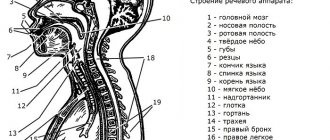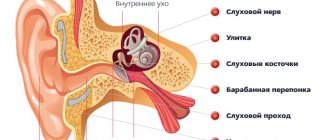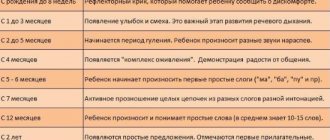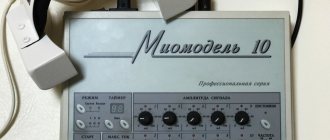Speech apparatus defects
The speech apparatus is a set of organs that are involved in sound pronunciation and speech formation. It consists of 2 sections: central and peripheral. The central part includes the brain, and the peripheral part includes muscles, bones, cartilage, and ligaments. Therefore, when we talk about disorders in the peripheral region, we are talking about the tongue, lips, soft palate and lower jaw. Disruption of the functioning of one or several organs of the speech apparatus at the same time leads to the appearance of speech disorders.
Defects of the speech apparatus, from a diagnostic point of view, can be divided into 2 groups. The first group will include disorders that are diagnosed at an early age; more often, already in the first month of a child’s life, examination reveals disorders that can only be corrected surgically.
The second group includes disorders that cannot be diagnosed at an early age. Their presence becomes known during the development of speech, most often at 2-2.5 years. In this case, you should seek help from a pediatric speech therapist. At the first consultation, the speech therapist will diagnose the disorders and, if necessary, refer you to related specialists.
If the first symptoms of speech disorders occur, you should immediately contact a speech therapist for diagnosis and selection of a correct and effective correction program.
Parents should contact a specialist if they notice:
- Stuttering or pronunciation of words too slow/fast, pauses between words;
- Voice disturbances, nasality, changes in voice timbre;
- Distortion or “swallowing” of sounds, inaudible speech, and others.
Our center’s specialists successfully work with speech apparatus defects; the following methods are most often used to correct speech disorders:
- Speech therapy massage;
- Special speech therapy exercises;
- DENAS therapy;
- Classes using Forbrain (the device can also be purchased for home use);
- Exercises for speech breathing and others.
The most common speech apparatus defects and methods of their correction:
Dysphonia (aphonia) is popularly called “voice disorder” or “vocal disorder”. Signs: lack of phonation or changes in the strength and timbre of the voice, nasality or hoarseness. Requires urgent correction, since with age the symptoms intensify and are less amenable to correction. In the treatment of dysphonia, articulation and breathing exercises, massage of the collar area, and exercises with the DENAS apparatus are most often used.
Stuttering is a disturbance in the tempo, rhythm and fluency of speech caused by convulsions of the speech apparatus. In children, it most often occurs during the development of phrasal speech. In the absence of timely correction, stuttering can accompany a person into adulthood. This disorder is difficult to correct due to its obsessive nature. Treatment of stuttering at the Ember Center is aimed at eliminating the pathological factors that led to the onset of stuttering, as well as neutralizing its consequences, fear of speech - logophobia. It is thanks to an integrated approach that it is possible to get rid of stuttering not temporarily, but forever.
A short frenulum is a defect of the oral cavity, which, as a rule, is congenital. With this disorder, the child cannot pronounce some sounds. Often, with a short frenulum, it is recommended to solve the problem surgically, especially at an early age, when the work of a speech therapist is not yet possible. But this can often be avoided with timely contact with a speech therapist. With the help of special exercises, you can stretch the frenulum, thereby solving this problem.
A dome-shaped palate is a defect of the speech apparatus caused by the incorrect structure of the oral cavity. The speech therapist teaches how to pronounce sounds that are inaccessible to the client, which will not differ from traditional ones by ear.
Rhinolalia (cleft palate) is characterized by a defective structure and functioning of the speech apparatus. A cleft palate interferes with normal voice production. A person with such a defect grossly distorts sounds, pronounces words nasally, and his voice timbre changes. In the treatment of such disorders, a surgical method is often used, after which a course of sessions with a speech therapist is required.
Dysarthria is a violation of the muscle tone of the articulatory apparatus, which contributes to the development of speech production disorders. With dysarthria, speech motor skills, breathing, voice and pronunciation of sounds are impaired. In this case, correctional classes with a speech therapist are aimed at eliminating the cause of the violations. The specialist uses articulation gymnastics, speech therapy massage, and DENAS therapy.
Defects of the speech apparatus are often found in people, but it is in childhood that they can be most effectively treated. With age, correction of these violations becomes more difficult and time-consuming.
Correction of speech apparatus defects at the Ember center is carried out according to an individually developed program. For complex disorders, we recommend a joint consultation with several specialists: a clinical psychologist, a speech pathologist, a special education teacher, and a neuropsychologist. An integrated approach helps to accurately determine the diagnosis and its causes, develop a correction route, without missing important details.
If your child has a speech defect that interferes with normal speech, sign up for a consultation by calling +7 (812) 642-47-02 or leave a request on the website.
Peripheral department of the speech apparatus; educational and methodological material on the topic
The main organs of articulation are the tongue, lips, jaws (upper and lower), hard and soft palates, and alveoli. Of these, the tongue, lips, soft palate and lower jaw are movable, the rest are immobile. The main organ of articulation is the tongue. The tongue is a massive muscular organ. When the jaws are closed, it fills almost the entire oral cavity. The front part of the tongue is mobile, the back part is fixed and is called the root of the tongue. The movable part of the tongue is divided into the tip, the leading edge (blade), the lateral edges and the back. The complexly intertwined system of tongue muscles and the variety of their attachment points provide the ability to change the shape, position and degree of tension of the tongue within a wide range. This is very important, since the tongue is involved in the formation of all vowels and almost all consonant sounds (except labials). An important role in the formation of speech sounds also belongs to the lower jaw, lips, teeth, hard and soft palates, and alveoli. Articulation consists in the fact that the listed organs form slits, or closures, that occur when the tongue approaches or touches the palate, alveoli, teeth, as well as when the lips are compressed or pressed against the teeth. The volume and clarity of speech sounds are created thanks to resonators. Resonators are located throughout the extension pipe. The extension tube is everything that is located above the larynx: the pharynx, oral cavity and nasal cavity. In humans, the mouth and pharynx have one cavity. This creates the possibility of pronouncing a variety of sounds. In humans, the pharynx and mouth form a common tube - the supernatus. It performs the important function of a speech resonator. The extension pipe in humans was formed as a result of evolution. Due to its structure, the extension pipe can vary in volume and shape. Changes in the shape and volume of the extension pipe are of great importance for the formation of speech sounds. These changes in the shape and volume of the extension pipe create the phenomenon of resonance. As a result of resonance, some overtones of speech sounds are enhanced, while others are muffled. Thus, a specific speech timbre of sounds arises. For example, when pronouncing the sound a, the oral cavity expands, and the pharynx narrows and elongates. And when pronouncing a sound, and vice versa, the oral cavity contracts and the pharynx expands. The larynx alone does not create a specific speech sound; it is formed not only in the larynx, but also in resonators (pharyngeal, oral and nasal). When producing speech sounds, the extension pipe performs a dual function: a resonator and a noise vibrator (the function of a sound vibrator is performed by the vocal folds, which are located in the larynx). The noise vibrator is the gaps between the lips, between the tongue and the teeth, between the tongue and the hard palate, between the tongue and the alveoli, between the lips and teeth, as well as the closures between these organs broken by a stream of air. Using a noise vibrator, voiceless consonants are formed. When the tone vibrator is turned on simultaneously (vibration of the vocal folds), voiced and sonorant consonants are formed. The oral cavity and pharynx take part in the pronunciation of all sounds of the Russian language. If a person has correct pronunciation, then the nasal resonator is involved only in pronouncing the sounds m and n and their soft variants. When pronouncing other sounds, the velum palatine, formed by the soft palate and the small uvula, closes the entrance to the nasal cavity.Causes of peripheral disorders
These are mainly anatomical disorders of the speech organs. 1) Congenital clefts of the uvula (“bicornuated” uvula) or the uvula with a soft palate, or the entire palate. In the most severe cases, the cleft extends to the upper jaw and upper lip, dividing them into two parts. As a result of cleft palate, the air exhaled during speech passes into the nose, which gives the voice an unpleasant nasal timbre (nasality). 2) A cleft of the upper lip, causing the lips to not close tightly (p, b are pronounced like f, v). 3) Malocclusions: open bite (anterior or lateral), sharply protruding upper or lower jaw. 4) Deformations of the teeth, jaws, and palate, often caused by rickets, make it difficult to pronounce certain sounds. 5) Short frenulum of the tongue, which interferes with pronunciation. 6) Hearing impairment (deafness, hearing loss). With early deafness, speech does not develop at all in a child; with hearing loss, it is difficult. 7) Violation of the vocal apparatus (larynx), as a result of which the voice either completely disappears (only whispered speech is possible) or becomes hoarse.
Some anatomical causes are the result of improper child care (poor hygiene of the mouth, ear, and nose). For example, for a long time, sometimes up to 2-3 or more years, children suck hard horns or fingers, which deforms the teeth, jaws and palate. A horn or finger presses in the palate or stretches the jaws, disrupting the correct position of the teeth.
If there are anatomical disorders and anomalies, contact a specialist doctor. However, medical care alone is not enough; the child must be taught how to properly use the improved organ of speech. This is the job of the teacher.
But even if there are some anatomical defects in the peripheral organs of speech, it is still possible, although with great difficulty, to teach a child correct pronunciation, since in humans the biological is overcome by social (training, upbringing) based on the leading role of the central nervous system. Higher nervous activity, due to the extraordinary plasticity of the brain, is capable of adapting defective organs to speech. This is why often children with irregular jaws or teeth still speak normally.
In addition to pathogenic factors that directly cause painful phenomena, called producing causes, there are also factors that contribute to the emergence or development of painful phenomena in speech, predisposing to them. These are often called soil diseases. “We must,” writes I.P. Pavlov, “to bear in mind both different reasons and different soils, which, of course, should entail both different degrees and different courses, even of the same basic painful disorder.” The soil does not have a decisive influence on the occurrence and course of speech disorders. Violation occurs without it, under the influence of producing causes alone. But it facilitates the implementation of the latter and enhances their effectiveness. The cause may be overwork, insufficient nutrition, prolonged lack of sleep, or weakening of the body by previous diseases. Some of the diseases listed on page 33 as causes of disturbances may also be considered soil causes in other cases. Often, the causes of speech disorders begin to act long before their consequences are discovered, for example, in cases of supposedly “causeless” stuttering.
Speech deficiencies observed in normal kindergarten children can be summarized as follows. 1. The most common age-related features of breathing, voice, pronunciation (from babbling speech in the younger group to individual sounds in the older group), tempo and rhythm of speech. 2. Pathological defects (tongue-tied, nasal, stuttering, residual effects of alalia or aphasia) are much less common. From the above it is clear that the causes of speech disorders are not isolated, unchangeable and insurmountable. There is much that families and educators can do to prevent or overcome these disorders.
Congenital preconditions for speech defects are extremely rare. Exaggerating the role of heredity in the formation of speech leads to a harmful attitude: if tongue-tiedness or stuttering is hereditary, then it is useless to fight it. Only features of the anatomical structure of the speech organs (special structure of some parts of the brain, protruded jaw, sparse teeth, etc.) and increased or decreased excitability of the nervous system as a whole can sometimes be transmitted hereditarily. Both can only alleviate the manifestations of speech defects, but do not cause them and, in any case, do not condemn children to lifelong speech impairment. The main problem of a child is not that he is born with some defects in the speech apparatus, but that he sometimes lives in conditions unsuitable for normal speech development .
Khvattsev M. E.
The structure of the speech apparatus
The speech apparatus consists of two closely interconnected parts: the central (or regulatory) speech apparatus and the peripheral (or executive) (Fig. 1).
The central speech apparatus is located in the brain. It consists of the cerebral cortex (mainly the left hemisphere), subcortical ganglia, pathways, brainstem nuclei (primarily the medulla oblongata) and nerves going to the respiratory, vocal and articulatory muscles.
What is the function of the central speech apparatus and its departments?
Speech, like other manifestations of higher nervous activity, develops on the basis of reflexes. Speech reflexes are associated with the activity of various parts of the brain. However, some parts of the cerebral cortex are of primary importance in the formation of speech. These are the frontal, temporal, parietal and occipital lobes of predominantly the left hemisphere of the brain (in left-handers, the right). The frontal gyrus (inferior) is a motor area and is involved in the formation of one's own oral speech (Broca's area). The temporal gyri (superior) are the speech-auditory area where sound stimuli arrive (Wernicke's center). Thanks to this, the process of perceiving someone else’s speech is carried out. The parietal lobe of the cerebral cortex is important for understanding speech. The occipital lobe is a visual area and ensures the acquisition of written speech (the perception of letter images when reading and writing). In addition, the child begins to develop speech thanks to his visual perception of the articulation of adults.
The subcortical nuclei control the rhythm, tempo and expressiveness of speech.
Conducting pathways. The cerebral cortex is connected to the speech organs (peripheral) by two types of nerve pathways: centrifugal and centripetal.
Centrifugal (motor) nerve pathways
connect the cerebral cortex with the muscles that regulate the activity of the peripheral speech apparatus. The centrifugal pathway begins in the cerebral cortex in Broca's center.
From the periphery to the center, i.e. from the region of the speech organs to the cerebral cortex, centripetal paths go.
Centripetal path
begins in proprioceptors and baroreceptors.
Proprioceptors
are found inside muscles, tendons and on the articular surfaces of moving organs.
Rice. 1. Structure of the speech apparatus: 1 - brain: 2 - nasal cavity: 3 - hard palate; 4 - oral cavity; 5 - lips; 6 - incisors; 7 - tip of the tongue; 8 - back of the tongue; 9 - root of tongue; 10 - epiglottis: 11 - pharynx; 12 —
larynx; 13 - trachea; 14 - right bronchus; 15 - right lung: 16 - diaphragm; 17 - esophagus; 18 - spine; 19 - spinal cord; 20 - soft palate
Structural components of speech
Responsible for speech function:
- The sensory speech center is the perception of speech sounds, based on the sound discrimination system of the language; Wernicke's area in the left hemisphere of the brain is responsible for this process.
- The center of motor speech - Broca's area is responsible for it, thanks to it it is possible to reproduce sounds, words and phrases.
In this regard, in clinical psychology there is the concept of impressive speech, in other words, the understanding and presentation of oral and written speech. There is also the concept of expressive speech - that which is spoken out loud accompanied by a certain tempo, rhythm, and emotions.
In the process of speech formation, each person should have a clear understanding of the following subsystems of their native language:
- phonetics (what syllables, sound combinations can be, their correct structure and combination);
- syntax (understanding exactly how the relationships and combinations between words occur);
- vocabulary (knowledge of the vocabulary of the language)
- semantics (the ability to understand the meaning of words long before acquiring pronunciation skills);
- pragmatics (relationships between sign systems and those who use them).
The phonological component of a language means knowledge of the semantic units of the language (phonemes). Physically, speech sounds can be divided into noises (consonants) and tones (vowels). Any language is based on a certain distinctive feature; if you change one of them, the meaning of the word will change dramatically. The main semantic distinguishing features include deafness and sonority, softness and hardness, as well as stress and unstress. It is these features that act as the basis of the phonemes of the language system. Each language has a different number of semantic units, usually from 11 to 141.
The Russian language involves the use of 42 phonemes, in particular, 6 vowels and 36 consonants.
It has been scientifically proven that any healthy infant in the first year of life has the ability to reproduce 75 different shortest sound units, in other words, can learn any language. But, most often, children at the initial stages of their development are in only one language environment, so over time they lose the ability to reproduce sounds that do not belong to their native Russian language.
Voice formation
In every language on our planet there is a specific number of sounds that create the acoustic image of the language. The sound finds meaning only in the scheme of sentences and helps to distinguish one letters from others. This sound is called a phoneme of the language. All sounds of a language differ in articulatory characteristics, that is, their difference comes from the formation of sounds in the human speech apparatus. And by acoustic characteristics - by differences in sound.
The voice can be considered the result of the hard work of the muscles of various components of the peripheral speech apparatus. Three of its departments contribute to the formation of sound:
- respiratory, otherwise energetic - includes the lungs, bronchi, trachea and throat;
- voice-forming department, otherwise generator - the larynx along with sound cords and muscles;
- sound-producing, otherwise resonator - the cavity of the oropharynx and nose.
The work of these departments of the speech apparatus in complete symbiosis can only occur through the central control of speech and voice-forming processes. This suggests that the respiratory process, articulatory mechanism and sound formation are completely controlled by the human nervous system. Its impact also extends to peripheral processes:
- the functioning of the respiratory organs regulates the power of the voice;
- the functioning of the oral cavity is responsible for the formation of vowels and consonants and for the difference in the articulatory process during their formation;
- The nose section provides adjustment of the overtones of the sound.
The central speech apparatus occupies a key place in the formation of the voice. The human jaw and lips, palate and supraglottic lobe, pharynx and lungs are all involved in the process. The air flow leaving the body, going further through the larynx and passing through the mouth and nose is the source of sound. On its way, the air passes through the vocal cords. If they are relaxed, then the sound is not formed and passes freely. If they are close and tense, the air creates vibration as it passes. The result of this process is sound. And then, with the work of the movable organs of the oral cavity, the direct formation of letters and words occurs.








